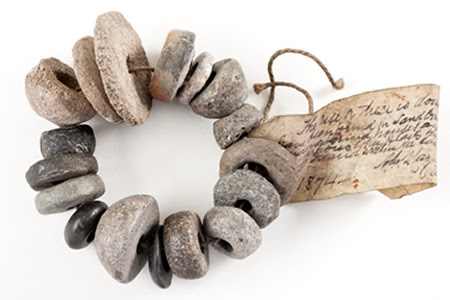Tha e coltach gu robh bàl Nollaig air a chumail le daoin’-uaisle Uibhist a Deas air 25 Dùbhlachd 1872, ’s dòcha ann an Taigh Mór Àisgeirnis. An cupall a bha a’ fuireachd anns an taigh, bha iad air ùr thighinn dhan eilean a’s t-samhradh: fear Seumas Drever á Arcaibh a bha a-nis ag obair mar bhàillidh na h-oighreachd, eadar Beinn na Faghla agus Barraigh, agus a bhean. Gu mì-fhortanach, chan eil sinn buileach cinnteach fhathast gu dé a b’ ainm dhi. Choisinn Drever deagh chliù bho na h-eileanaich, gu h-àraid an taca ris a’ bhàillidh roimhe, William Birnie a bha ’na chùis-ghràin aig móran de’n tuath.
Am measg muinntir Uibhist a thàinig air chéilidh orra, math dh’ fhaoidte le aon sùil air ‘preusant’ Nollaig bho’n fhear-taighe, bha boireannach bochd á Staoidhligearraidh air an robh Catrìona Nic an Tòisich. Rinn ise òran beag dha na Drevers, a-réir coltais an ìre mhath ás a seasamh – air uaireannan tha briathran, ciall, agus meadrachd a’ dol tarsainn air a chéile – air fonn ‘Càit’ an caidil an rìbhinn a-nochd?’ Bha Alasdair MacGilleMhìcheil an làthair aig a’ bhàl cuideachd, agus sgrìobh e sìos na facail. Feumaidh gu robh e airson na rannan eadar-theangachadh dhan chupall as déidh làimh – ach faodaidh teagamh a bhith againn an robh e buileach cho fosgailte ’s a bha a’ bhana-bhàrd fhéin mu bhòidhchead Bhean-Phòsda Drever. Dh’ fhaodadh e bhith nach robh nòsan na sean bhàrdachd mòlaidh a’ freagairt air modhalachd linn Bhictòria!
A-réir Alasdair: ‘The bard is 40 y[ea]rs and at poetry all that time & she is greatly oblig[ed] to Mrs Dre[ver] for her munificence & kindness’. Tha seo car àraid: ann an da-rìribh, tha e coltach gu robh Catrìona Nic an Toisich a’ teannadh ri 70 bliadhna a dh’ aois aig an àm – chan eil fhios nach robh i a’ tarraing ás a’ ghàidsear air an oidhch’. Co-dhiù, thill Alasdair air ais thuice ann an 1875, agus chruinnich e bhuaipe grunn òrthachan a chaidh a chlò-bhualadh ann an Carmina Gadelica, leabhar far a bheil e a’ cuimhneachadh oirre mar chuideigin aig an robh ‘much occult lore’.
Fàilte dhuibh a chòmhlain thàinig
Faisg a chòmhnaidh:
Mr Drever ’s fhir na mara,
’S an leadaidh àlainn còmhl’ riutha.
’S tric a thug mi treis ’am thàmh
’S a chuir mi dàin an òrdan,
’S gun dèan mi fear do dhan lànail [i.e. lànan]
Òg a tha air pòsadh.
’S nuair ràinig mise taigh a’ bhàla
Far an robh pàirt dha m’ sheòrsa,
Bha’n còmhlan uasal air an ùrlar
’G ùmhlachadh dhan cheòl ann.
Ghléidh iad urram air na Gàidheil,
[?Gach] leadaidh is bean òg ann:
An cas siùbhlach ’s an ceum lùthmhor,
An troigh nach lùbadh feòirnean.
’S nuair a thàinig iad ás an ruidhle
O rinn iad m’ fheòraich
Dh’ fhaighnich iad gu ciùin ’s gu sìobhalt’
An gabhainn fhéin dhaibh òran.
Thuirt mi gur e mise nì siud
Fiosrach cinnteach eòlach.
A’ cheart mhion[aid] rinn mi sguir dheth
Shìn iad ginidh òir dhomh.
Ge brith chall a chuir siud orra
’S bu chuid[eachadh] dhomhs’ e
Gum bu làn a bhios an spòrs
’S gum bu pailt’ an stòras.
[?Tric sibh tarraing iall a chluaise
Toirt rud uaibh gach lò ás]
Gum bu sona saoghal réidh
Bhios sibh fhéin ’nur còmhlan.
’S gum fada bhios an Drever.
’Na bhàillidh aig Iain Gòrdan
A chuile taobh a nì e gluas’d
Beannachd nan uaislean ’na chòmhdhail.
’S ann mar ri beannachdan na tuath'
’S gun robh a’ bhuaidh r’a bheò dha.
O na bheachdnaich mi gu glan
Air do chéile pòsda,
Chan fhaca mi[se] fhéin ’s a bhàl
Leithid bean ur còdaich.
Fàinneachan òir air a meuran
’S deise an t-sìod’ an òrdan
Air a seang shlios fallainn
Gineil banail [slios] mar chanach mòintich.
Cìochan corrach air a brollach
’S broitseachan an òir oirr',
Muineal is gile na’n fhaoileann
No’n sneachd air taobh nam mór-bheann.
A dà ghruaidh cho dearg ris na caorainn
No gàradh chraobh nan ròsan,
A sùil[ean] meala fo’n chaol mhala
Cridhe glan gun mhórchuis.
’S buidh’ an Drever rinn a buannachd
’S e fhuair an stòras
Bean bhanail chiallach a ?dhearbhas
Fiosrachadh is còiread.
Chan iongnadh pròis bhith air a h-athair
’S air a càirdean móra
Bho chionn a’ mheas a ghléidh i dhaibh
O thàinig i air bhòidse.
An leadaidh uasal a bha leibh
Mo dhùrachd i bh’ air pòsadh
’S tha mìle beannachd a’ bhàird chuagaich
A-nis ’s gach uair r’a beò dhuibh.
A song composed by Catherine Mackintosh, Staoidhligearraidh, South Uist, to the wife – unfortunately, we don’t yet know her name – to the recently arrived James Drever, factor to the Long Island Estate, apparently when the young couple were holding a Christmas ball at Àisgeirnis House on 25 December 1872. The poem was preserved by Alexander Carmichael, who must have attended the ball with his wife (and his field notebook!) to be translated for the Drevers later. Carmichael’s translation may not have been so frank concerning Mrs Drever’s physical charms as the poetess, working in the traditional idiom of Gaelic panegyric.
Thanks to Ray Burnett and Angus Macmillan for their kind help and assistance.
Tagairtean
LS CW 106 fos.42–43v.
Ìomhaigh:
Taigh Àisgeirnis









